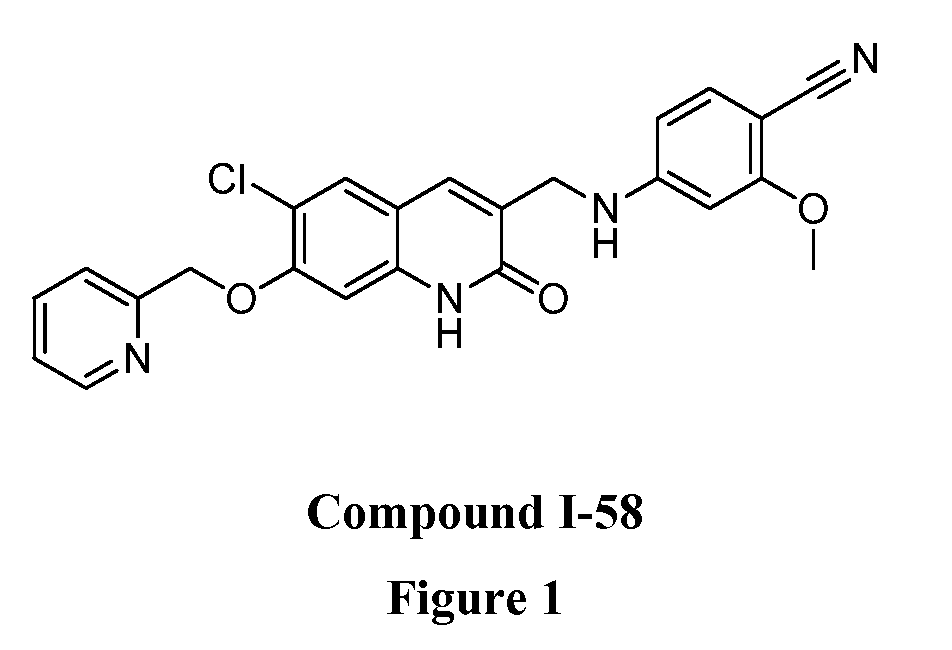Phenyl quinolinone derivatives as mutant-isocitrate dehydrogenase inhibitors
a technology of phenyl quinolinone and inhibitors, which is applied in the direction of drug compositions, organic chemistry, extracellular fluid disorder, etc., can solve the problem of aml patients' inability to dedifferentiate from hematopoietic progenitor cells, and achieve the effect of improving the dedifferentiation
- Summary
- Abstract
- Description
- Claims
- Application Information
AI Technical Summary
Benefits of technology
Problems solved by technology
Method used
Image
Examples
example 1
ate II-1: (S)-3-(1-aminoethyl)-6-chloroquinolin-2(1H)-one hydrochloride
[0441]
Step-1: (R,E)-N-((2,6-dichloroquinolin-3-yl)methylene)-2-methylpropane-2-sulfinamide
[0442]
[0443]To a mixture of 2,6-dichloroquinoline-3-carbaldehyde (15.0 g, 66.37 mmol) and (R)-2-methylpropane-2-sulfinamide (8.85 g, 73.14 mmol) in 1,2-dichloroethane (150 mL) was added CuSO4 (16.0 g, 100.25 mmol). The resulting mixture was heated to 55° C. and stirred at 55° C. overnight. After TLC and MS showed complete disappearance of starting materials, the mixture was cooled to room temperature and filtered through a pad of Celite®. The pad of celite was then rinsed with CH2Cl2. The filtrate was evaporated to dryness in vacuo and purified by SiO2 column chromatography (0 to 25% hexanes / EtOAc) to afford the title compound, (R,E)-N-((2,6-dichloroquinolin-3-yl)methylene)-2-methylpropane-2-sulfinamide, as a yellow solid (17.7 g, 81% yield).
Step-2: (R)-N-((S)-1-(2,6-dichloroquinolin-3-yl)ethyl)-2-methylpropane-2-sulfinamide...
example 2
ate II-2: (R)-3-(1-aminoethyl)-6-chloroquinolin-2(1H)-one hydrochloride
[0448]
Step-1: (R)-N-((2,6-dichloroquinolin-3-yl)methylene)-2-methylpropane-2-sulfinamide
[0449]To a mixture of 2,6-dichloroquinoline-3-carbaldehyde (500 mg, 2.21 mmol) and (R)-2-methylpropane-2-sulfinamide (295 g, 2.43 mmol) in 1,2-dichloroethane (15 mL) was added CuSO4 (530 mg, 3.31 mmol). The resulting mixture was heated to 55° C. and stirred at 55° C. for 18 hours. Once TLC and MS showed complete disappearance of starting materials, the reaction mixture was cooled to room temperature and filtered through a pad of Celite®. The pad of celite was then rinsed with CH2Cl2. The filtrate was evaporated to dryness in vacuo and purified by column chromatography on an ISCO® chromatography system (SiO2; hexanes to 60% EtOAc / hexanes) to afford the title compound, (R)-N-((2,6-dichloroquinolin-3-yl)methylene)-2-methylpropane-2-sulfinamide, as a yellow solid (510 mg, 70% yield).
Step-2: (R)-N-((R)-1-(2,6-dichloroquinolin-3-yl)...
example 3
ative Approach to Intermediate II-1
[0453]
Step-1: 3-acetyl-6-chloroquinolin-2(1H)-one
[0454]
[0455]A mixture of 2-amino-5-chlorobenzaldehyde (0.5 g, 3.21 mmol) and 2,2,6-trimethyl-4H-1,3-dioxin-4-one (0.594 g, 4.18 mmol) in xylenes (10 mL) under an atmosphere of nitrogen was heated to reflux for 3 hours and then cooled to room temperature. The reaction mixture was filtered and washed with xylenes twice to afford the title compound, 3-acetyl-6-chloroquinolin-2(1H)-one (330 mg, 46.3%). 1H NMR (300 MHz, DMSO-d6): δ ppm 12.22 (br, 1H), 8.41 (s, 2H), 8.00 (s, 1H), 7.63 (d, J=8.8 Hz, 1H), 7.32 (dd, J1=8.8 Hz, J2=2.5 Hz, 1H), 2.58 (s, 3H). LCMS (Method 1): m / z 222.94 [M+H]+.
Step-2: ((S)-N-((S)-1-(6-chloro-2-oxo-1,2-dihydroquinolin-3-yl)ethyl)-2-methyl propane-2-sulfinamide
[0456]
[0457]A mixture of tetraethoxytitanium (144 mg, 0.632 mmol), (S)-2-methylpropane-2-sulfinamide (38.3 mg, 0.316 mmol), and 3-acetyl-6-chloroquinolin-2(1H)-one (70 mg, 0.316 mmol) in THF (20 mL) was heated to 80° C. over...
PUM
 Login to View More
Login to View More Abstract
Description
Claims
Application Information
 Login to View More
Login to View More - R&D
- Intellectual Property
- Life Sciences
- Materials
- Tech Scout
- Unparalleled Data Quality
- Higher Quality Content
- 60% Fewer Hallucinations
Browse by: Latest US Patents, China's latest patents, Technical Efficacy Thesaurus, Application Domain, Technology Topic, Popular Technical Reports.
© 2025 PatSnap. All rights reserved.Legal|Privacy policy|Modern Slavery Act Transparency Statement|Sitemap|About US| Contact US: help@patsnap.com



